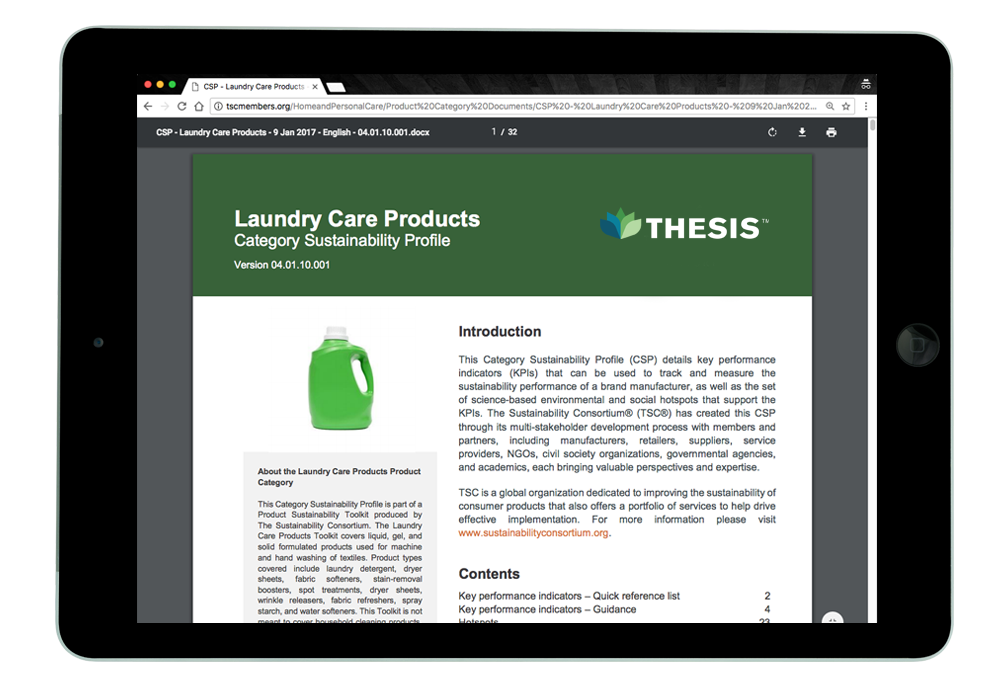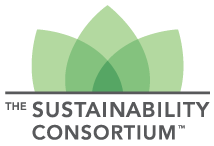MEASUREMENT AND REPORTING SYSTEM
OUR METHODOLOGY AND RESEARCH BACKGROUNDKey Performance Indicators stem from the idea that innovation in consumer goods sustainability can be driven throughout the supply chain when key decision makers ask the right questions of their partners and collectively act on what they learn.
TSC has a rigorous methodology to evaluate available scientific knowledge, identify environmental and social impacts, and identify improvement opportunities for many different types of consumer products, as well as Key Performance Indicators (KPIs) for assessing product category-level sustainability performance.
KEY PERFORMANCE INDICATOR SETS
1. Define the Product Category
TSC members, staff, and invited experts select a category of products to examine.
2. Review Relevant Scientific Sources
TSC reviews a range of scientific sources for information relevant to the product category.
3. Research Hotspots
Evidence is sought for hotspots, which are activities in the product life cycle that cause social or environmental impact.
4. Research Improvement Opportunities
Evidence is sought to support improvement opportunities that can address the hotspots.
5. Evaluate the Evidence
The evidence is evaluated against several criteria to determine if it will be included in the toolkit.
6. Design Key Performance Indicators (KPIs)
Key Performance Indicators are designed that allow measurement of manufacturers’ progress against the hotspots.
7. Multi-stakeholder Review
All the elements are assembled into the Key Performance Indicator Sets documents and go through two rounds of review from members.
8. Publish the KPI Set
The KPI set and supporting documents are published and are available for communication by members and licensees.
9. Update and Revise the KPI’s
The KPI set is updated as needed based on new research, feedback from users, and analysis of reporting results.
THE LIFE CYCLE PERSPECTIVE
The questionnaires are designed with manufacturers, suppliers, and retail buyers in mind, but address more than sustainability in manufacturing. Social and environmental hotspots throughout the product category life cycle are included, from raw material extraction to product disposal.
THE MULTI-STAKEHOLDER PROCESS
Members of TSC include stakeholders from business, civil society, government, and academia convened by TSC to collaboratively develop the TSC questionnaires and supporting documents. The process is focused on creating credible, scalable, and effective tools through Sector Working Groups with regular workshops, discussions, and commenting in which all members are welcome to participate.
THE FINAL TOOLS
Key Performance Indicators
THESIS key performance indicators detail the hotspots, sustainability issues, improvement opportunities, and key performance indicators for a product category.

FREQUENTLY ASKED QUESTIONS
Will TSC KPIs change?
TSC updates THESIS content, including KPIs, annually, based on new research, feedback from stakeholders, and analysis of reporting results.
The Release Notes section at the end of the PDF version of the KPI set outlines all changes.
What is the process for producing a THESIS assessment?
First, TSC research staff and stakeholders define the boundaries of the product category and review published research for evidence of social and environmental impacts and improvement opportunities.
In an established process, the quality and quantity of evidence is evaluated for inclusion in THESIS as a hotspot or improvement opportunity.
Based on this analysis, Key Performance Indicators (KPIs) are developed that link hotspots and improvement opportunities to specific metrics.
From there, Sustainability Snapshots are developed by mapping hotspots to business objectives and sustainability issues to create a one-page summary of the THESIS KPI document.
Supply Chain Diagrams are in the process of being developed for all product categories.
This THESIS Help Center video provides more information. Email [email protected] for password
How and when is it decided what product categories will be included in THESIS?
How are stakeholders involved in the process of developing THESIS?
The Sustainability Consortium engages corporate, academic, government, and non-governmental organizations as stakeholders.
Stakeholders bring expertise and industry insight to the development of THESIS assessments throughout the entire process. In addition to attending workshops, stakeholders submit written feedback and input to the drafts of documents that are created.
Who can participate in the review of THESIS?
TSC members and other invited stakeholders provide input to TSC to help identify possible hotspots and improvement opportunities associated with a product category. They also review and provide feedback on THESIS content and tools to help make them accurate and actionable.
How can experts who are not part of TSC membership engage?
TSC researchers and members reach out to external stakeholders when we start work on a new product category, and experts can provide input to the research process.
Will TSC assessment scopes change?
TSC completes a yearly revision on THESIS content based on new research and feedback from stakeholders. This might introduce new assessments or revisions to current KPIs. Any changes stemming from this process will be provided to TSC Stakeholders and logged at the bottom of the PDF version of the KPI Guidance.
You may notice new, simpler names or more specific options than were available in past years, but the underlying KPIs for each assessment have generally not changed.
Why are there questions about issues that are already well-regulated or managed?
THESIS KPIs are developed based on research and stakeholder participant input for global applicability. Issues that may not seem differentiating for one organization or region may be differentiating in other markets.
Why is a certain issue or hotspot missing from my assessment?
TSC only includes issues and opportunities that are materially significant and actionable, as is defined by the quality and quantity of supporting (or conflicting) scientific evidence.
TSC uses a structured research process to identify published research studies and then checks the interpretation of that evidence through a multi-stakeholder review.
Learn more on our Methodology and Research Background.
